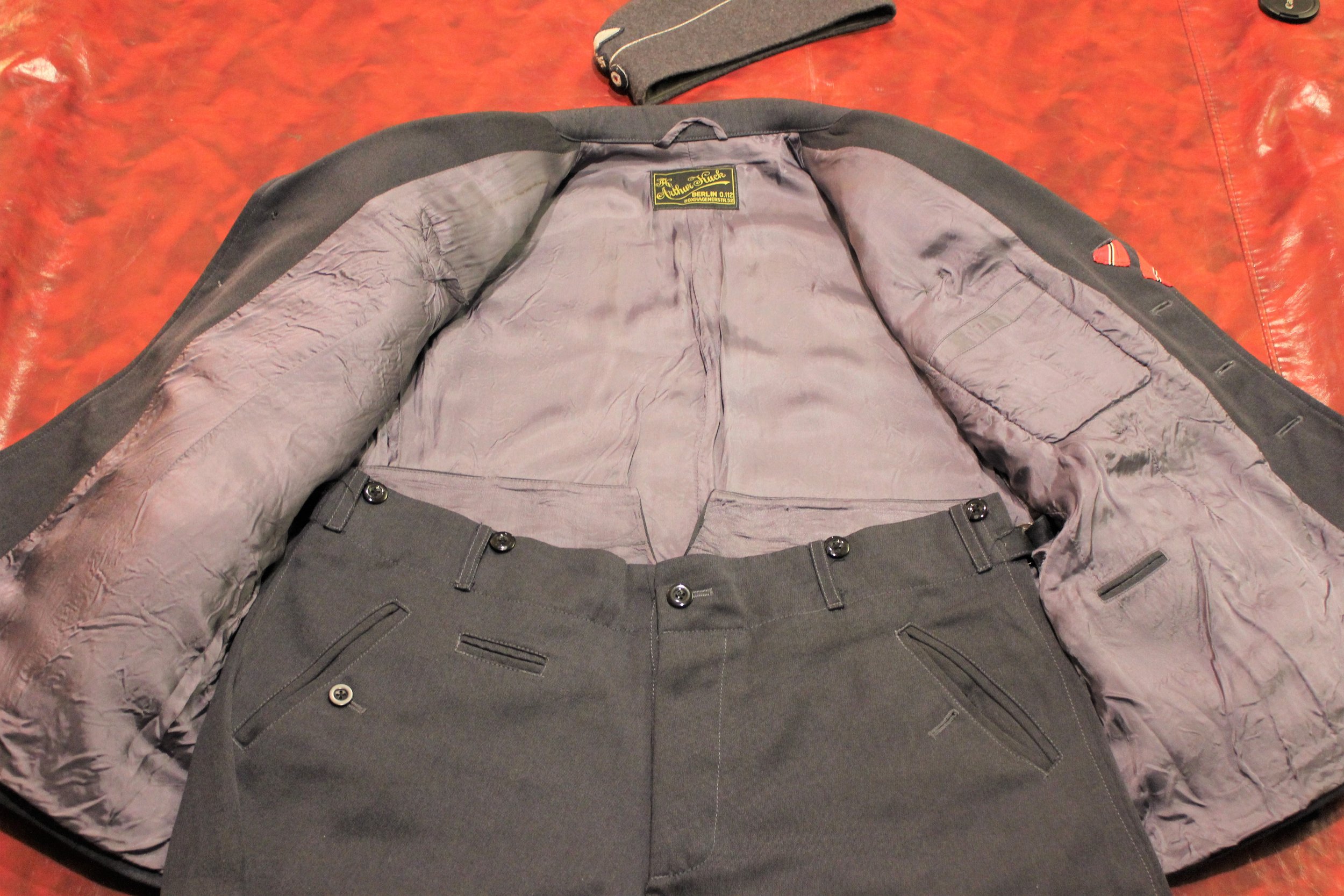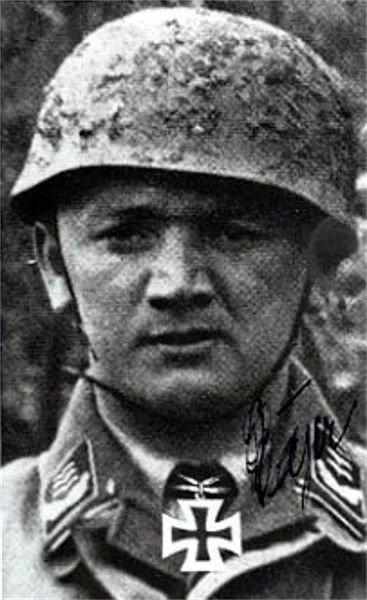Luftwaffe Sanitats-Kompanie:
Fallschirmjager Medical Unterfeldwebel, Fallschirmjager Regiment. 2:
This Unterfeldwebel has campaigned with FJR.2 since it was formed. Taking part in the campaigns in the Sudetenland and Czechoslovakia, Poland, and Norway in 1939, and into Belgium and Holland by 1940, then into the Balkans and Greece, including the landing at Rethimnon in 1941. Despite the brutal losses on Crete, the Fallschirmjager units began an expansion into division levels.
With divisional expansion, the Unterfeldwebel campaigned in the swamps of the Wolchow. When the ground thawed in 1942, there was no relief from the mosquitoes but more from the mud. The wounded had to be rowed out in small boats.
Wounded, the Unterfeldwebel was sent to Italy as part of the support for wounded returning from North Africa, and then in 1943, as FJ set up shop in France at Nimes. The peace in the south of France did not last long, though, with the invasion of Sicily and then Italy, the wounded coming in with every ship and plane, the FJ moved to secure Rome as the Italian Fascist Government fell.
In November, the first battalion of FJR2 made the jump to counter the British invasion of the Greek island of Leros. Along with other German units, including elements of the Brandenburgers, this strategic island was retaken. The island along with others in the region had been held by the Italians for years and Leros had large Naval Guns mounted on it high above the ocean overlooking the sea passages; this was the background for the movie “The Guns of Navarone”.
The end of 1943 found the Unterfeldwebel back in Russia, fighting the Red Army. In Shitomir, he hunkered in for a long winter of combat that was sure to come. By the Spring of 1944, the depleted unit was moved to a peaceful Western Front to rebuild in the Cologne area. But once again, his rest was short-lived. After D-Day, the regiment was in reserve, then went to Brest. But Brest fell in September, and FJR.2 was able to escape the siege. FJR.2 found itself in Holland in January of 1945.
The Unterfeldwebel wears a standard Fliegerbluse favored by the Fallschirmjager. His blue Waffenfarbe shows his medical affiliation, and one of the few elements of the FJR to not wear the Dark Yellow of the Flight Personnel. The most interesting element of the blues is the Fallschirm-Jager RGT. 2 cuff title, normally reserved for the four-pocket uniform.
His Ribbons Bar traces his actions in combat. He wears the Kreta cuff title for his actions in that operation as well as the Italian German-Afrika ribbon for his service supporting the wounded in Italy after the evacuation. Wounded several times in Russia during the 1943-44 campaign times he wears the 1939 wound badge in Silver. For Compat leadership, he’s earned the Iron Cross Second Class in Greece and the 1st Class on Kreta. This paratrooper training took place at Sendal, where he was awarded the Luftwaffe Fallschirmjager Abzeichen. The Luftwaffe medical trade patch is sewn on his left sleeve with matching NCO ciphers mounted on his shoulder boards.
When not in combat, he wears standard Feldblau trousers with Fliegermutz and standard boots. In combat, he will wear the Fallschirmjager trousers, snug-lacing boots, and jump-smock with rank devices sewn onto the arms of it.
Luftwaffe Doctor, Rolf Jäger, 1st Fallschirmjager Regiment, 1st FJR. Division 1:
Jager received his commission as a doctor in the Luftwaffe in 1938, with initial service starting in January 1930 with the 6th Ambulance Division. In 1940 Jager was transferred to Sturmabtilung Kock. an element of the 7. Fleigerdivision.
Sturmabteilung Koch was a lead strike element that attacked the heavily armed fortress of Eben Emael and major road bridges to enable the Germans to drive into Belgium. The Sturmabteilung or Assault Group “Beton”, in 11 Gliders from the Airport Cologne-Ostheim, attacked and took possession of the important bridge at Vroehoven. The Belgian demolition of the bridge was prevented by the determined assault by the Fallschirmjager.
While under enemy fire, Dr. Jager recovered and treated several German wounded from the bridge, and was awarded the Knight’s Cross of the Iron Cross, as well as several other leaders of Sturmabteilung Koch.
Dr. Jager was appointed as the Oberarzt to I./ Fallschirmjager Regiment 1. Taking Part in the assault on Crete, Jager then went with the regiment to the Eastern Front, finally ending the war in Italy, at Anzio, then as the director of the military hospital at Treviso. He continued as a staff surgeon at the hospital, as a POW under British Control until January 1947.
Dr. Jager wears a standard Luftwaffe Officers’ Walking-Out uniform. The officer grade cuff title for “FJR 1” is worn on the right sleeve, while the campaign cuff title of “Krete” is on the left. His award of the Iron Cross 1st class and Fallschirmjager Abzeichen are on the left pocket, with the Iron Cross 2nd class and his Long Service awards on his ribbons bar. Following the regimental deployment to the Soviet Union, Jager was awarded the “Ost Front” Medal and wears the ribbon threw the center button-hole of the jacket, in Battlefield fashion.
Collar and Shoulder insignia are piped in the dark-blue Waffenfarben of the Medical Corps. The uniform was worn with the Luftwaffe Schirmmutz, or Feldmutz Breeches with tall “Officers Boots”, a standard-issue powder blue shirt, and an Officers-belt belt complete the uniform.
“NEW” Luftwaffe Sanitär, custom M44 cut/splinter jacket:
Now, where did I put this story?
Gefreiter Sanitätsabteilung ,,Hermann Göring” Italy 1944:
Following the surrender of Panzer Division “Hermann Göring” with the remnants of the Afrika Korps, a new division was reformed under the same name and sent to Sicily. The allies invaded in July of 1943, and most of the Italian units quickly surrendered. The division was one of the few reliable formations that remained. It fought at Gela and Priolo, but it was forced back due to the naval bombardment. It continued fighting a defensive battle while the German forces were evacuated from Sicily during Operation Lehrgang and were among the last units to leave Sicily.
It was stationed near Naples when the Italian government surrendered to the Allies, and it was used to disarm the Italian troops in the Salerno area. The allies landed at Salerno in early September, and the division engaged in a fighting withdrawal from Salerno and later from Naples and the Volturno-Termoli Line in mid-October. It retreated with the rest of the German troops to the Gustav Line and was removed from the front lines where it was replaced by infantry troops.
Troops, led by Oberstleutnant Julius Schlegel, moved the treasures of the Monte Cassino Monastery including paintings by da Vinci, Titian, Raphael, & others along with the remains of St. Benedict, 70,000 historical books and 1,200 documents to safety in the Vatican, thus saving them from destruction during the battle of Monte Cassino. Schlegel was to spend seven months in Allied prisons after the war as a suspected looter and war criminal before being freed by Field Marshal Alexander and the testimony of the Monte Cassino monks.
When the Allies landed at Anzio in January 1944, the division was rushed from the Gustav Line to hold the Americans on the beachhead. It fought ferociously at Cisterna, and the Germans managed to fight the Allies to a virtual standstill.
The corps size Fallschirm-Panzerkorps Hermann Göring was created in 1944 by combining the unit with the Fallschirm-Panzergrenadier Division 2 “Hermann Göring”. With the start of Operation Diadem in mid-May, the division retreated towards Rome and then abandoned the city. Eventually withdrawn from Italy, the division fought the remainder of the war on the Eastern Front.
M1929 Telo Mimetico pattern camouflage was used by the Italian army for shelter halves and later for uniforms. Being first issued in 1929 and only fully discontinued in the early 1990s, it has the distinction of being the first printed camouflage pattern for general issue, and the camouflage pattern in longest continuous use in the world.
In 1941, Telo Mimetico was adopted by the Germans and distributed to Waffen-SS units operating in Italy and Normandy during the spring and summer of 1944. Most frequently published photos show members of the 1. u 12. SS-Panzer Divisions wearing the Telo Minetico print cut into SS issue items. After the Italian surrender, stocks of the Italian pattern were captured and used on other fronts. Panzer Division “HG” was issued Waffen SS camouflage in place of the standard Luftwaffe Splinter; period photos show troops using Telo Minetico.








































































